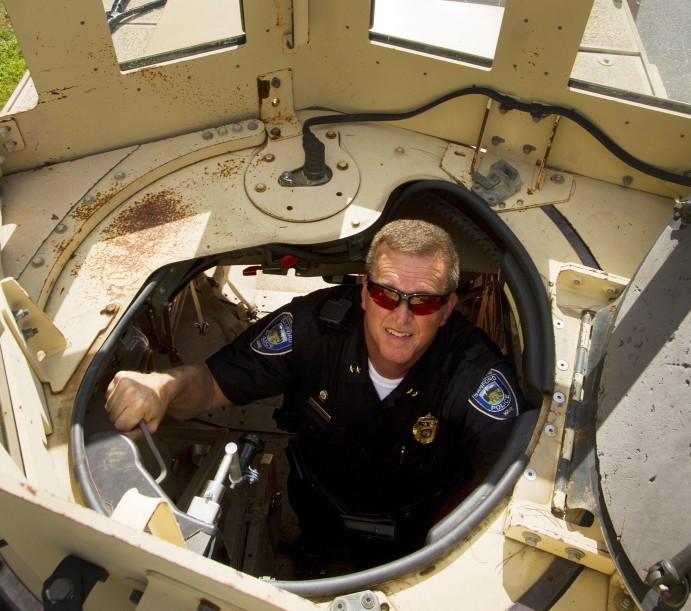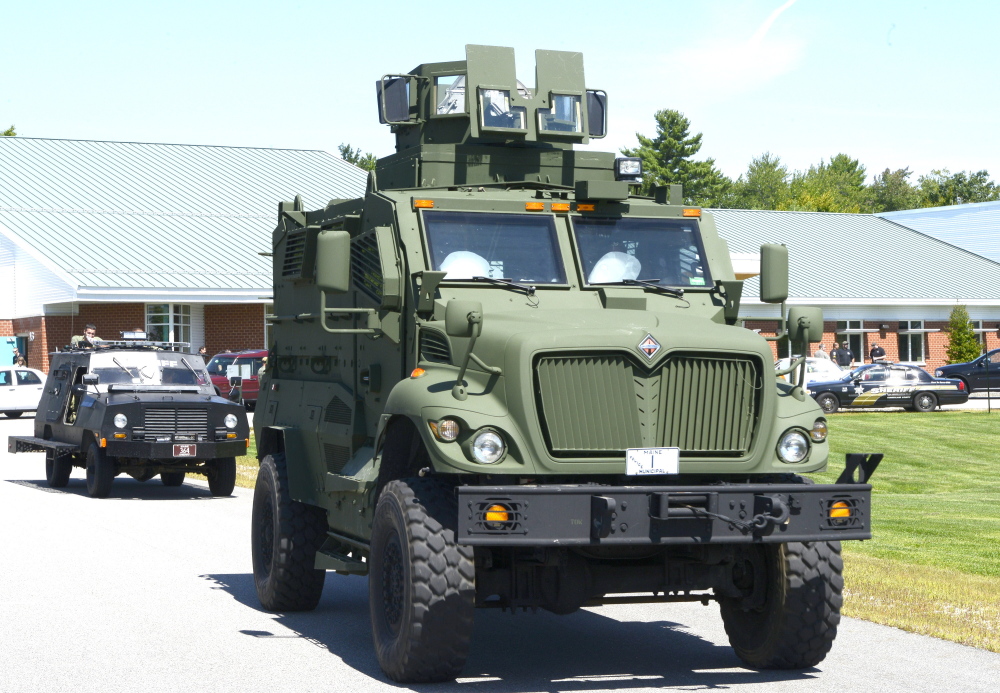Rifles, night-vision goggles, body armor and a few massive vehicles designed to withstand roadside bombs are among the military equipment that law enforcement agencies in Maine have acquired at little cost from the U.S. Department of Defense.
Through a program that redistributes surplus military gear to local law enforcement agencies, Maine received more than $12 million in military hand-me-downs from 2006 to May 2014, although the majority consists of basics such as cold-weather underwear, office equipment, medical supplies and motor oil.
But researchers and civil libertarians are concerned that outfitting local departments with other gear more suited to combat situations negatively affects how police interact with the communities they’re sworn to protect.
Images of protesters in Ferguson, Missouri, facing local police equipped with military-style riot gear have sparked a national conversation about the growing militarization of local police forces, and how they should balance community policing with risks posed by violent criminals or deranged citizens.
“Obviously we haven’t seen a situation in Maine like what we’ve seen in Ferguson yet, but the capacity is certainly there,” said Rachel Healy, director of communications and public education for the American Civil Liberties Union of Maine. “Just the existence of this militarized equipment often tends to escalate situations when we should be attempting to de-escalate them.”
Local law enforcement officials in Maine, however, said that people should view the use of battlefield gear as proof that police are taking steps to keep the public and officers safe during rare but increasingly dangerous confrontations between police and armed criminals.
“It sounds a little callous, but when people stop shooting at us or threatening us or threatening the community, we can have that conversation about not being prepared for it,” South Portland Police Chief Edward Googins said. “But the reality is people do do that, and we have to be prepared for it.”
South Portland’s violent crime rate – including murder, rape, aggravated assault and robbery – was just under 20 per 10,000 people in 2012, the most recent year figures were available. That compares to a national rate of 39 violent crimes per 10,000 residents.
Like police agencies across the country, Maine departments have increased their firepower and armor with military-style equipment, some of it surplus Defense Department equipment, and some of it paid for by grants from federal agencies. Because the equipment comes from several federal agencies and programs, it’s not clear how many armored vehicles, perhaps among the most visibly intimidating military equipment acquired by local agencies, have come to Maine.
Both South Portland and Sanford, which have armored vehicles, have used them at least once this year: South Portland during a standoff that turned into a suicide, and Sanford to serve a warrant on a suspect in an armed bank robbery. Portland used its armored vehicle during an incident in 2011 in the Riverton apartment complex in which police were in a standoff with several men they believed were armed. Several people were arrested, but no guns were found.
The equipment upgrade is occurring despite a violent crime rate in Maine – 12 violent crimes per 10,000 residents – that is less than one-third the national average. But police say failing to prepare for a violent incident invites trouble.
“There are some people who say nothing happens in Sanford and Wells and Kittery and Berwick, but that’s putting your head in the sand,” said Sanford Police Chief Thomas Connolly, who leads a regional response team that handles potentially violent situations in the region. The violent crime rate in York County is 14 incidents per 10,000 people, and in Sanford, it is 30 violent crimes per 10,000 people.
“If you look all over the country, no one thought that horrific incident in Sandy Hook would happen, but it did,” he said. “At Columbine (High School), no one expected someone would go into a school and start shooting. Now the standard has changed.”
The national conversation about police use of military equipment comes after Mike Brown, an unarmed black teenager, was shot and killed by a white officer on Ferguson’s predominantly white police force. Public protests over Brown’s shooting have turned into a national discourse over allegations of racial bias and police brutality, fueled by images of protesters facing off against police in riot gear lobbing tear gas and firing rubber bullets into the crowds.
On Monday, President Barack Obama called for a review of programs that supply local law enforcement with military equipment, and lawmakers plan to review and possibly limit the type of equipment that is transferred through the Defense Department program.
“This Ferguson, Missouri, incident, it’s an isolated incident,” Oxford County Sheriff Chief Deputy Hart Daly said. “There’s going to be a knee-jerk reaction across the country. It’s a bad thing for law enforcement and the citizens we protect.”
Daly’s department was approved to receive a $658,000 mine-resistant vehicle, but decided it could not afford the $10,000 it would cost to ship the vehicle across the country. Daly’s officers would have benefited from it during a standoff with an armed man in Mexico last weekend, he said. During the incident, three officers were pinned down behind their cruisers by the man, who died from police gunshots. Had the department owned an armored vehicle, those officers could have been ferried to safety.
Connolly, the Sanford chief of police strongly defended the police’s right to have military-style gear, but criticized how police in Ferguson have used it.
Instead of starting at the lowest possible level of confrontation, Ferguson police appeared to gear up immediately, he said.
“If you start at that level, where do you go?” he said. “I’m not saying I wouldn’t have that stuff available. I’d have it down the street and around the corner.”
Such shows of force, say experts in policing and psychology, influence how people behave, not always as police intend.
Far from being cowed into compliance, people tend to react aggressively when weapons are involved, said Brad Bushman, professor of mass communication and psychology at Ohio State University.
“Just the mere presence of a weapon can make people (those without the weapons) more aggressive,” he said. “Police officers now are dressing more like Army soldiers. A police officer is (supposed) to help other people out and protect them. An Army soldier’s job is to kill people and (they are) dressed to do that efficiently and effectively.”
Bushman said the response is not a conscious decision.
“That’s the most impressive thing about the ‘weapons effect.’ If people thought about it, they would do just the opposite,” he said.
The national ACLU launched a project a year ago to document the increasing militarization of police, particularly with respect to the war on drugs and the use of SWAT teams to serve basic warrants or apprehend non-violent criminals. The danger is that tactical shifts can change the role of police, said Healy, spokeswoman for Maine’s ACLU.
“We absolutely want our police to have the equipment they need to be safe and to keep us safe, but the first rule should be to de-escalate and not escalate,” she said. “I believe the situation in Ferguson never would have gotten to the situation it was at, but for the actions of police: shooting an unarmed black man, followed by inappropriate policing of peaceful protests.”
Peter Kraska, chair of graduate studies and research at Eastern Kentucky University’s School of Justice Studies, is one of the first researchers to extensively study police militarization. He said that even as departments have talked in recent decades about doing more community policing to improve public relations, a corresponding trend toward the paramilitarism of SWAT teams has taken place.
That now pervades police institutions, so that in many communities, the police are viewed as an “occupying force” and police perceive the public as “enemy combatants.” That can lead to police using deadly force inappropriately and losing legitimacy in the public’s eyes, he said.
The use of military equipment also has an impact on officers, said Maria Haberfeld, chair of the law, police science and criminal justice administration department at John Jay College of Criminal Justice in New York City.
“I do believe that police departments, regardless of their size, could benefit from upgraded or military-grade equipment,” she said, noting that criminals are sometimes better equipped than police and some incidents do require a SWAT team response. However, use of military style hardware can influence the police culture, particularly in smaller departments.
“If you have this kind of equipment, you say what is more of your role now, ‘Officer Friendly, social worker-type or am I a soldier?’ ” Haberfeld said.
“Police, regardless of the size of the department, have a responsibility to make explicit to their troops that these equipments are there for very specific situations – violent bank robber, active shooter,” she said, “and never to be used against crowds out there demonstrating or exercising civil rights.”
Copy the Story LinkSend questions/comments to the editors.





Success. Please wait for the page to reload. If the page does not reload within 5 seconds, please refresh the page.
Enter your email and password to access comments.
Hi, to comment on stories you must . This profile is in addition to your subscription and website login.
Already have a commenting profile? .
Invalid username/password.
Please check your email to confirm and complete your registration.
Only subscribers are eligible to post comments. Please subscribe or login first for digital access. Here’s why.
Use the form below to reset your password. When you've submitted your account email, we will send an email with a reset code.